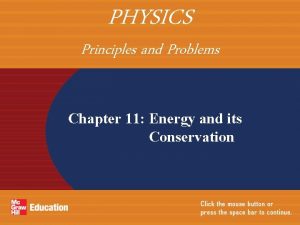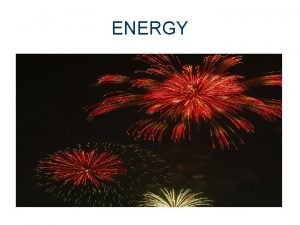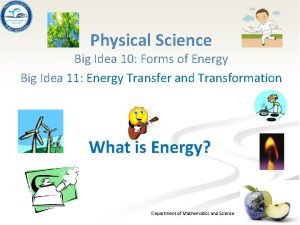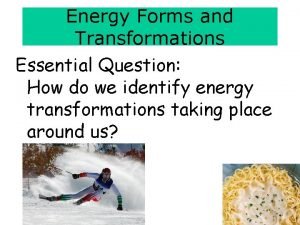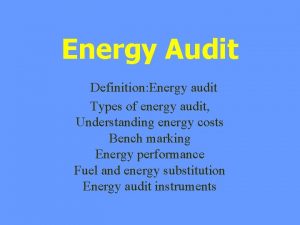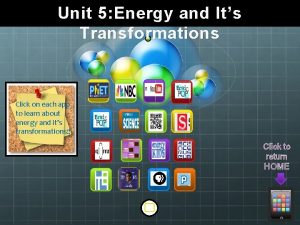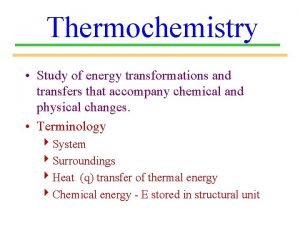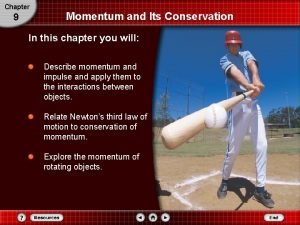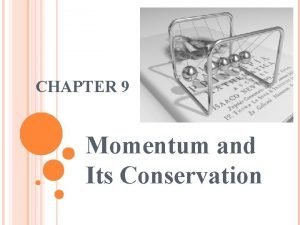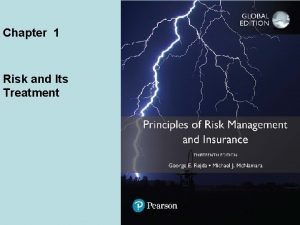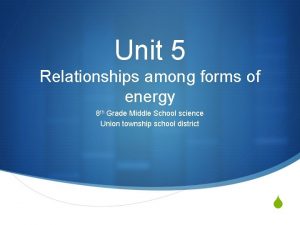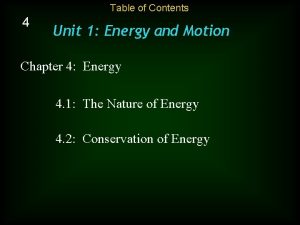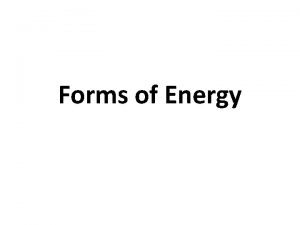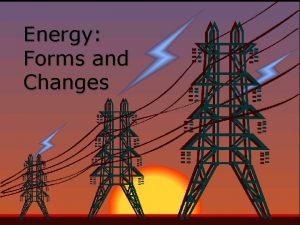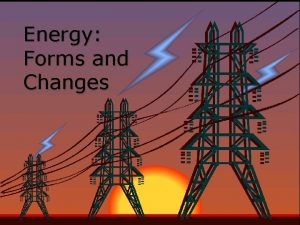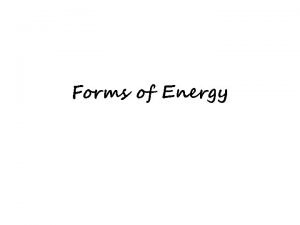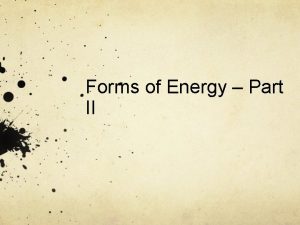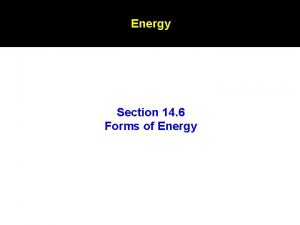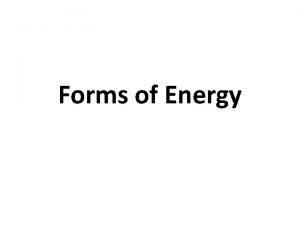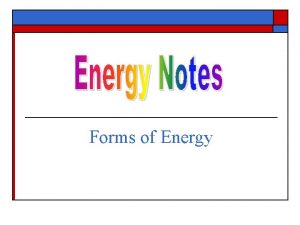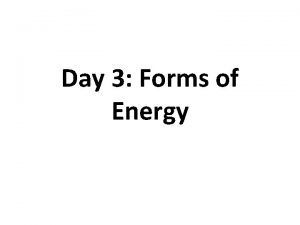CHAPTER 15 ENERGY Energy and Its Forms Energy






































- Slides: 38

CHAPTER 15 – ENERGY

Energy and Its Forms

Energy Energy = the ability to do work Energy is always transferred when work is done There are several forms of nrg, and nrg is constantly being transformed from one form to another! What types of nrg are present in this picture?

The Law No matter what – the total amount of NRG in the universe NEVER changes! NRG is neither created or destroyed

You CAN’T create or destroy nrg, but you CAN transform nrg from one type to another! Example: Eating. When you eat, you transform food nrg into chemical nrg used by your muscles.

Types of Energy Kinetic Energy � NRG of motion � Depends on mass and speed KE = ½ mv 2

Calculating KE A 0. 10 kg bird is flying at a constant speed of 8. 0 m/s. What is the bird’s KE? KE = ½ mv 2 � Start with what you know! m = 0. 10 kg v = 8. 0 m/s KE = ½ (0. 10 kg) ( 8. 0 m/s) 2 = 3. 2 J MATH PRACTICE pg 448 1 -3

Types of Energy cont… Potential NRG � NRG that is stored as a result of position or shape � 2 forms Gravitational Potential NRG Elastic Potential NRG

Types of PE Gravitational Potential NRG PE that depends on the object’s height, mass and acceleration due to gravity g. PE = mgh �g = 9. 8 m/s/s Elastic Potential NRG PE of an object that is stressed or compressed. � Springs! � Rubber bands!

Gravitational PE practice Remember g. PE = mgh Suppose the diver at the top oa a 10. 0 m high platform has a mass of 50 kg. What is her PE relative to the ground (or gravitational PE? ) m = 50 kg, g = 9. 8 m/s/s, h = 10. 0 m (50 kg)(9. 8 m/s/s)(10. 0 m ) = 4900 J

ALL NRG CAN BE CONSIDERED KINETIC OR POTENTIAL!!! You can also have NRG produced in fields produced by ELECTROMAGNETIC

Forms of Energy The major forms of NRG are � Mechanical � Thermal � Chemical � Electromagnetic � Nuclear

Mechanical Energy NRG of the motion and position of everyday objects Not limited to machines ME = PE + KE

Thermal Energy Remember – all the particles around you are in CONSTANT MOTION This constant motion requires NRG – kinetic NRG! Thermal NRG = the total KE and PE of all the microscopic particles

Chemical Energy The NRG stored in chemical bonds When the bonds are broken, the released NRG can do work

Electrical Energy NRG of electric charges Can exert forces that do work

Electromagnetic Energy A form of NRG that travels through space in waves

Nuclear Energy stored in atomic nucleii Remember – The nucleus of an atom is held together by nuclear forces. These nuclear forces have a tremendous amount of PE!

Energy Conversion and Conservation

Conservation of Energy The LAW – again � NRG can not be created or destroyed. EVER. Period. � You can convert NRG all you want BUT the amount of NRG present at the beginning of the process is ALWAYS the same at the end.

Energy Conversion NRG can be converted from one form to another � Examples Wind-up toys = elastic potential NRG. When spring unwinds, e. PE KE as the toy moves! Light bulbs convert electrical NRG into thermal and electromagnetic Lighting a match – this uses a series of steps to convert NRG Chemical NRG in muscles of fingers – friction then converts some of the match’s KE to thermal NRG – thermal NRG triggers a chemical RXN to release chemical NRG – chemical NRG thermal NRG and electromagnetic NRG in the flame

Energy Conversions Most common NRG conversions is between PE and KE Conversions between PE and KE can happen in BOTH directions. PE KE and KE PE Examples � g. PE of an object is converted to KE of motion as the object falls � Compression of spring – when spring is released, elastic PE converted to KE

Energy Conversions Pendulums �A pendulum consists of a weight swinging back and forth on a rope or string � KE and PE undergo constant NRG conversion in a pendulum

Pendulums At the highest point in its swing, the pendulum is momentarily motionless. KE = 0 PE at max! At the highest point in its swing, the pendulum is momentarily motionless. Pendulum swings down, PE KE At bottom of swing, PE = 0 and KE at max!

Energy Conversion Calculations More math! Conservation of Mechanical NRG � Remember – Mechanical NRG = KE + PE � Apply the LAW to any mechanical process! So (if friction is ignored) the ME at the beginning is the same as the ME at the end! ME REMAINS CONSTANT! (KE + PE)beginning = (KE + PE)end

Using Conservation of ME equation At a construction site, a 1. 50 kg brick is dropped from rest and hits the ground at a speed of 26. 0 m/s. Assuing air resistance can be ignored, calculate the g. PE of the brink before it was dropped. � What info are you given? Mass = 1. 50 kg Speed, v = 26. 0 m/s

At a construction site, a 1. 50 kg brick is dropped from rest and hits the ground at a speed of 26. 0 m/s. Assuing air resistance can be ignored, calculate the g. PE of the brick before it was dropped. � What g. PE does it ask you to find? of the brick before it was dropped

At a construction site, a 1. 50 kg brick is dropped from rest and hits the ground at a speed of 26. 0 m/s. Assuing air resistance can be ignored, calculate the g. PE of the brink before it was dropped. � What equations/formulas do you know that will help you? (KE + PE)beginning = (KE + PE)end KE = ½ mv 2

At a construction site, a 1. 50 kg brick is dropped from rest and hits the ground at a speed of 26. 0 m/s. Assuing air resistance can be ignored, calculate the g. PE of the brink before it was dropped. � Plug in the values you know! (KE + PE)beginning = (KE + PE)end (0 + PE)beginning = (KE + 0)end PE beginning = KE end PE = KE = ½ mv 2

At a construction site, a 1. 50 kg brick is dropped from rest and hits the ground at a speed of 26. 0 m/s. Assuing air resistance can be ignored, calculate the g. PE of the brink before it was dropped. � Now PE plug in your known values! = ½ (1. 50 kg)(26. 0 m/s/s)2 = 507 J Math Practice pg. 458 1 – 3

Energy Resources

Nonrenewable Energy Resources These exist in limited quatities Once used they can not be replaced except over millions of years � Oil � Natural gas � Coal � Uranium Fossil Fuels – formed underground from the remains of once-living organisms

Renewable Energy Resources that CAN be replaced in a relatively short period of time Originate directly or indirectly from the sun � Hydroelectric � Solar � Geothermal � Wind � Biomass � (and possibly) nuclear fission

Renewable Energy Resources Hydroelectric NRG � NRG from flowing water � As H 2 O flows downhill, PE KE � Low production cost and low pollution

Renewable Energy Resources Solar NRG � Sunlight converted into usable NRG � Thermal NRG, and electrical NRG (by solar cells) � Nonpolluting, but not practical for rainy areas

Renewable Energy Resources Geothermal NRG � Thermal NRG below earth’s surface � Thermal NRG of volcanoes can be converted to electrical NRG � Nonpolluting, but not widely available.

Renewable Energy Resources Biomass NRG – sulight causes plants to grow converting electromagnetic NRG to chemical NRG which can be converted into thermal NRG � Burn wood etc… Hydrogen fuel cell – generates electricity by reacting H and O. � Nuclear fission

Conserving Energy Resources Reduce NRG needs Increase efficiency of NRG use GO GREEN!
 Short and long forms
Short and long forms Strong forms
Strong forms Eroei
Eroei Form of emigree
Form of emigree Its halloween its halloween the moon is full and bright
Its halloween its halloween the moon is full and bright Physics chapter 11 study guide answers
Physics chapter 11 study guide answers Chapter 11 energy and its conservation answers
Chapter 11 energy and its conservation answers Why are related forms more agreeable than unrelated forms
Why are related forms more agreeable than unrelated forms Why are related forms more agreeable than unrelated forms
Why are related forms more agreeable than unrelated forms Why are related forms more agreeable than unrelated forms?
Why are related forms more agreeable than unrelated forms? When a train increases its velocity its momentum
When a train increases its velocity its momentum Windy cloudy rainy sunny
Windy cloudy rainy sunny If its square its a sonnet
If its square its a sonnet Its not easy but its worth it
Its not easy but its worth it What are 6 forms of energy
What are 6 forms of energy What is energy
What is energy Energy forms and transformations
Energy forms and transformations Energy energy transfer and general energy analysis
Energy energy transfer and general energy analysis Energy energy transfer and general energy analysis
Energy energy transfer and general energy analysis 5 forms of business ownership
5 forms of business ownership Food web words
Food web words Need of energy audit ppt
Need of energy audit ppt The study of energy and its transformations.
The study of energy and its transformations. Virtual labs energy transformations
Virtual labs energy transformations Study of energy transformations
Study of energy transformations Chapter 22 section 5 the end of the war and its legacy
Chapter 22 section 5 the end of the war and its legacy Momentum and its conservation chapter 9
Momentum and its conservation chapter 9 Chapter 12 reconstruction and its effects
Chapter 12 reconstruction and its effects A 1875 kg car going 23 m/s
A 1875 kg car going 23 m/s Which is represented by the equation fδt = pf - pi ?
Which is represented by the equation fδt = pf - pi ? Chapter 17 manifest destiny and its legacy
Chapter 17 manifest destiny and its legacy Chapter 1 risk and its treatment
Chapter 1 risk and its treatment Chapter 5 elasticity and its application multiple choice
Chapter 5 elasticity and its application multiple choice What was reconstruction? *
What was reconstruction? * Chapter 3 section 1 england and its colonies
Chapter 3 section 1 england and its colonies Wind energy is actually an indirect form of
Wind energy is actually an indirect form of All forms of energy
All forms of energy The seven forms of energy
The seven forms of energy What are the main forms of energy
What are the main forms of energy





